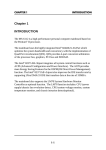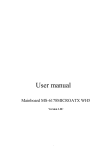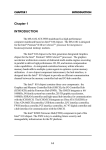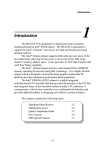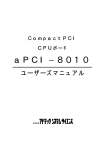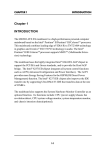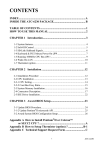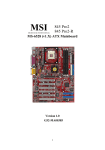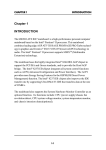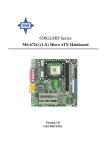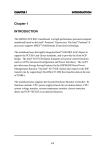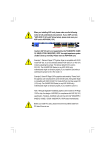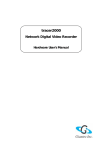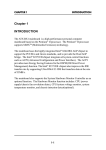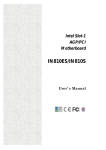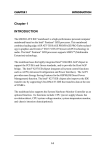Download DESKPOWER 2000 Series User`s Manual
Transcript
DESKPOWER 2000 Series User’s Manual Fujitsu endeavours to ensure that the information in this document is correct, but accepts no liability for any error or omission in the same. Any procedures described in this document for operating Fujitsu products should be read and understood by the operator before such products are used. To ensure that Fujitsu products function without risk to safety and health, such procedures should be strictly observed by the operator. The development of Fujitsu products and services is continuous and published information may not be up to date. Any particular issue of a product may contain facilities not described herein. It is important to check the current position with Fujitsu. Specifications and statements as to performance in this document are Fujitsu estimates intended for general guidance. They may require adjustment in particular circumstances and should therefore not be taken as formal offers or commitments. DESKPOWER is a trademark of Fujitsu Limited. The following are registered trademarks of Microsoft Corporation: MS, MS-DOS, Windows® NT, Windows® for Workgroups, Windows® 98. Pentium® and MMX™ technology are trademarks of Intel Corporation. Award is the registered trademark of Award Software International Inc. All other products are trademarks or registered trademarks of their respective companies. © Copyright 1999 Fujitsu Limited. All rights reserved. No part of this publication may be copied, reproduced, or translated without the prior written consent of Fujitsu Limited. No part of this publication may be stored or transmitted in any electronic form without the written consent of Fujitsu Limited. © Copyright Fujitsu PC (Asia) Pte Ltd Fujitsu PC (Asia) Pte Ltd 200 Pandan Loop #05-03 Pantech 21 The Computer Centre Singapore 128388 Tel: 65-776 0688 Fax: 65-776 0788 i She int _i-xv 1 19/1/00, 16:27 IMPORTANT SAFETY INSTRUCTIONS 1. Read these instructions carefully. Save these instructions for future reference. 2. Follow all warnings and instructions marked on the product. 3. Unplug this product from the wall outlet before cleaning. Do not use liquid cleaners or aerosol cleaners. Use a damp cloth for cleaning. 4. Do not use this product near water. 5. Do not place this product on an unstable cart, stand, or table. The product may fall, causing serious damage to the product. 6. Slots and openings in the cabinet and the back or bottom are provided for ventilation; to ensure reliable operation of the product and to protect it from overheating, these openings must not be blocked or covered. The openings should never be blocked by placing the product on a bed, sofa, rug, or other similar surface. This product should never be placed near or over a radiator or heat register, or in a built-in installation unless proper ventilation is provided. 7. This product should be operated from the type of power indicated on the marking label. If you are not sure of the type of power available, consult your dealer or local power company. 8. This product is equipped with a 3-wire grounding-type plug, a plug having a third (grounding) pin. This will only plug into a grounding-type power outlet. This is a safety feature. If you are unable to insert the plug into the outlet, contact your electrician to replace your obsolete outlet. Do not defeat the purpose of the grounding-type plug. 9. Do not allow anything to rest on the power cord. Do not locate this product where persons will walk on the cord. ii She int _i-xv 2 19/1/00, 16:27 10. If an extension cord is used with this product, make sure that the total ampere rating of the equipment plugged into the extension cord does not exceed the extension cord ampere rating. Also, make sure that the total rating of all products plugged into the wall outlet does not exceed 15 amperes. 11. Never push objects of any kind into this product through cabinet slots as they may touch dangerous voltage points that could result in a fire or electric shock. Never spill liquid of any kind on the product. 12. Do not attempt to service this product yourself, as opening or removing covers may expose you to dangerous voltage points or other risks. Refer all servicing to qualified service personnel. 13. Unplug this product from the wall outlet and refer servicing to qualified service personnel under the following conditions: a. When the power cord or plug is damaged or frayed. b. If liquid has been spilled into the product. c. If the product has been exposed to rain or water. d. If the product does not operate normally when the operating instructions are followed. Adjust only those controls that are covered by the operating instructions since improper adjustment of other controls may result in damage and will often require extensive work by a qualified technician to restore the product to normal condition. e. If the product has been dropped or the cabinet has been damaged. f. If the product exhibits a distinct change in performance, indicating a need for service. 14. CAUTION. When replacing the battery, be sure to install it with the polarities in the correct position. There is a danger of explosion if the battery is replaced with an incorrect type or is mistreated. Do not recharge, disassemble or dispose of in fire. Replace only with the same or equivalent type recommeded by the manufacturer. Dispose of the used battery according to the manufacturer’s instructions. 15. Use only the proper type of power supply cord set (provided in your keyboard manual accessories box) for this unit. It should be a detachable type: UL listed/CSA certified, type SVT/SJT, rated 6A 125V minimum, VDE approved or its equivalent. Maximum length is 15 feet (4.6 meters). iii She int _i-xv 3 19/1/00, 16:27 Starting your PC for the first time iv She int _i-xv 4 19/1/00, 16:27 Starting your PC for the first time Booting the System When you turn on your PC for the first time, it will display a Fujitsu logo on the screen. If you do nothing, the system will read the hard drive for the operating system software, flash the system configuration information on the screen, and then Setup Wizard Screen will appear. You will then be stepped through the Conditions of Use process. You must complete this initial process before you will be able to use your PC. If you turn off the power without using the on screen Cancel button, you will get an error message when you start your PC again. For system preload with Windows® 98, refer to Section A – Finishing Setup and Starting Windows® 98. Read Section B – Finishing Setup and Starting Windows® NT if your system preloads with Windows® NT. A. Finishing Setup and Starting Windows® 98 Conditions of Use Process The first time you start your PC, you must confirm your acceptance of the copyright limitations for your pre-installed software. After you complete the Conditions of Use process, these screens will not appear again. You cannot use your PC until the Conditions of Use process is completed. The bottom of each screen has a < Back button, a Next > button and a Cancel button which are activated by the integrated cursor control and button click. The < Back button will return you to the previous screen. The Next > button activates any choices or information you have entered and takes you on to the next screen. The Cancel button allows you to stop the Setup process. If you stop the process, your PC will start up at the beginning of the Windows® 98 Setup Wizard. User Information Fill in your name and your company name as you want the software licensed. When the information has been entered, click on the Next > button. You will not be allowed to continue until you make an entry. v She int _i-xv 5 19/1/00, 16:28 License Agreement Read the license agreement carefully. You can scroll through the text using the mouse to activate the scroll bar or use the up arrow ↑ and down arrow ↓ keys to move up and down the text one line at a time or use the Page Up or Page Down keys to move the text one screen at a time. When you finish reading, you must point and click to accept or reject the terms of the agreement and then click on the Next > button. If you reject the terms of the license agreement, you will be asked to review the license agreement for information on returning the Windows® 98 or to shutdown your PC. Certificate of Authenticity Look in the box that your PC came in and you will find a Windows® 98 Certificate of Authenticity and a Windows® 98 Users Manual. On the certificate and also on the back of the manual, you will find a barcode with a number above it. These numbers should be the same, they are your product code and the number you should enter on the Certificate of Authenticity screen. When you enter the number exactly as shown, click on the Next > button. vi She int _i-xv 6 19/1/00, 16:28 Time Zone When your PC has completely identified all of the installed hardware, it will display a dialog box entering which time zone you wish to set the clock to. Windows® Messaging Once you have selected a time zone, you will see a screen announcing that Windows® messaging is being set up. Printer Setup When the messaging setup is complete, a dialog box will appear for selecting which printer is to be attached to your system. You do not have to select a printer, so click on the Cancel button. If you wish to select a printer, click on the Next > button and answer the questions. Welcome to Windows® 98 Once you have completed the printer setup or chosen not to set up a printer at this time, you will see the welcome screen for Windows® 98. You can choose: Windows® Tour; What’s New; Online Registration; or Close. You are now in the Windows® 98 operating system and the Conditions of Use process will not be repeated. vii She int _i-xv 7 19/1/00, 16:28 B. Software Drivers and Application You will find a Composite CD packet in your accessories box. Please store the packet in a safe place in case there is a loss of data and it becomes necessary to reinstall your operating system and/or applications. The Composite CD will contain all the necessary drivers for re-loading. C. Learning About Your Operating System and Application Software Tutorials All operating systems and most application software have tutorials built-in. We highly recommend that you step through your tutorial before you use an application even if you are familiar with the same application on a different machine, an earlier version of the application, or a similar product. Manuals In the accessories box, you will find user manuals for Windows® 98 or other preinstalled software. We recommend that you review these manuals for general information on the use of these applications and to get a basic understanding of what is covered in the manual, and how it is organized, should questions arise as you use the applications. viii She int _i-xv 8 19/1/00, 16:28 About this manual ix She int _i-xv 9 19/1/00, 16:28 About this Manual Purpose This user’s guide aims to give you all the necessary information to enable you to operate the system properly. Manual Structure This user’s guide consists of two chapters. Chapter 1 System Board This chapter describes the system board and all its major components. It contains the system board layout, jumper settings, cache and memory configuration, and information on other internal devices. Chapter 2 BIOS Configuration This chapter gives information about the system BIOS and tells how to configure the system by changing the settings of the BIOS parameters. x She int _i-xv 10 19/1/00, 16:28 Conventions The following are the conventions used in this manual: Text entered by user Screen messages a, e, s, etc. Represents text input by the user. Denotes actual messages that appear on the screen. Represents the actual keys that you have to press on the keyboard. NOTE Gives bits and pieces of additional information related to the current topic. WARNING Alerts you to any damage that might result from doing or not doing specific actions. xi She int _i-xv 11 19/1/00, 16:28 contents SYSTEM BOARD 1.1 MAINBOARD FEATURES ................................................................. 3 1.2. MAINBOARD LAYOUT ..................................................................... 6 1.3. QUICK REFERENCE FOR JUMPERS & CONNECTORS ......................... 7 1.4 CASE CONNECTOR: JFP1 ............................................................... 8 1.4.1 1.4.2 1.4.3 1.4.4 1.4.5 1.4.6 table of Chapter 1 1.5 CLEAR CMOS JUMPER: JBAT1/J26 ............................................... 10 1.5.1 1.6 ESD PRECAUTIONS .......................................................... 12 PRE-INSTALLATION INSTRUCTIONS .................................... 12 POST-INSTALLATION INSTRUCTIONS .................................. 13 HARDWARE INSTALLATION ........................................................... 14 1.7.1 1.7.2 1.7.3 1.7.4 1.7.5 1.8 BIOS FLASH JUMPER: JP3 ................................................ 11 INSTALLATION PRECAUTIONS ....................................................... 12 1.6.1 1.6.2 1.6.3 1.7 Power Switch ..................................................................... 9 Reset Switch ..................................................................... 9 Power LED ........................................................................ 9 Speaker ............................................................................ 9 HDD LED .......................................................................... 9 Keylock ............................................................................. 9 CENTRAL PROCESSING UNIT: CPU .................................... 14 CPU INSTALLATION PROCEDURES ..................................... 14 CPU CORE SPEED DERIVATION PROCEDURE ...................... 15 OVERCLOCKING JUMPER: J2 ............................................ 15 FAN POWER CONNECTOR: CPUFAN ................................... 16 MEMORY INSTALLATION ............................................................... 17 1.8.1 1.8.2 1.8.3 MEMORY BANK CONFIGURATION ...................................... 17 MEMORY INSTALLATION PROCEDURES .............................. 18 MEMORY POPULATION RULES .......................................... 19 xii She int _i-xv 12 19/1/00, 16:28 1.9 POWER SAVING SWITCH CONNECTOR: JGS1 ................................. 20 1.9.1 POWER SAVING LED CONNECTOR: JGL1 ............................ 21 1.10 Onboard Audio Enabled/Disabled Jumper: JP4 .............................. 22 1.11 MODEM WAKE UP CONNECTOR: JMDM1 ....................................... 23 1.12 MODEM-IN: J6 ............................................................................. 24 1.13 AUX LINE IN CONNECTOR: J5 ....................................................... 25 1.14 CD-IN CONNECTOR: J8 ................................................................ 26 1.15 EXPANSION CARDS ..................................................................... 27 1.15.1 INSTALLING A PCI CARD ................................................... 27 Chapter 2 AWARD® BIOS SETUP 2.1 ENTERING SETUP ........................................................................ 29 2.2 GETTING HELP ............................................................................ 30 2.2.1. MAIN MENU .................................................................... 30 2.2.2. STATUS PAGE SETUP MENU / OPTION PAGE SETUP MENU .. 30 2.3 THE MAIN MENU ......................................................................... 30 2.4 STANDARD CMOS SETUP ............................................................. 32 2.5 ADVANCED BIOS FEATURES ......................................................... 34 2.6 ADVANCED CHIPSET FEATURES .................................................... 37 xiii She int _i-xv 13 19/1/00, 16:28 2.7 INTEGRATED PERIPHERALS .......................................................... 40 2.8 POWER MANAGEMENT SETUP ...................................................... 44 RELOAD GLOBAL TIMER EVENTS .................................................. 47 2.9 PNP/PCI CONFIGURATION SETUP ................................................. 47 2.10 FREQUENCY/VOLTAGE CONTROL .................................................. 49 2.11 LOAD FAIL-SAFE/OPTIMIZED DEFAULTS ......................................... 50 2.12 SET SUPERVISOR/USER PASSWORD ............................................ 51 xiv She int _i-xv 14 19/1/00, 16:28 She_Chp1_01-11 1 19/1/00, 16:28 INTRODUCTION The DESKPOWER 2000 is a high-performance computer based on Intel® 810 chipset. The board is designed for the Intel® CeleronTM (PPGA) processor for inexpensive business/personal desktop markets. The Intel ® 810 chipset is the first generation Integrated Graphics chipset for the Intel® CeleronTM processor. The graphics accelerator architecture consists of dedicated multi-media engines executing in parallel to deliver high performance 3D, 2D, and motion compensation video capabilities. An integrated centralized memory arbiter allocates memory bandwidth to multiple system agents to optimize system memory utilization. A new chipset component interconnect, the hub interface, is designed into the Intel 810 chipset to provide an efficient communication channel between the memory controller hub and I/O hub controller. The Intel® 810 chipset contains three core components: the Graphics and Memory Controller Hub (GMCH/GMCH0), the I/O Controller Hub (ICH0/ICH) and the Firmware Hub (FWH). The GMCH integrates a 66/100MHz, P6family system bus controller, integrates 2D/3D graphics accelerator, 100MHz SDRAM controller and high-speed hub interface for communication with the ICH0/ICH. The ICH0/ICH integrates an Ultra ATA/33(ICH0) or Ultra ATA/66(ICH) controller, USB host controller, LPC interface controller, FWH interface controller, PCI inter face controller, AC’97 digital controller and a hub interface for communication with the GMCH/GMCH0. The Intel® 82802 Firmware Hub (FWH) component is part of the Intel® 810 chipset. The FWH is key to enabling future security and manageability infrastructure for the PC platform. 2 She_Chp1_01-11 2 19/1/00, 16:28 1.1 MAINBOARD FEATURES CPU • Suppor t Socket370 for Intel® CeleronTM processor. Chipset • Intel® 810 (GMCH/GMCH0) chipset. (421 BGA) - Integrated Graphics Controller - Intel DDM Architecture - SDRAM memory Independent of System Bus - Support 4MB Display Cache (only for GMCH) • Intel® ICH/ICH0 chipset. (241 BGA) - AC’97 Controller Integrated - 2 full IDE channels, up to ATA66 (only for ICH) - Low pin count interface for SIO Front Side Bus (FSB) • 66/100MHz clocks are supported. Main Memory • Suppor t two 168-pin DIMM sockets. • Suppor t a maximum memory size of 256MB(64Mbit technology) or 512MB(128Mbit technology) SDRAM. Slots • Three 32-bit Master PCI Bus slots. • Suppor t 3.3v/5v PCI bus Interface. On-Board IDE • An IDE controller on the ICH/ICH0 chipset provides IDE HDD/CD-ROM with PIO, Bus Master, Ultra DMA/33 and Ultra DAM/66 operation modes. • Can connect up to four IDE devices. 3 She_Chp1_01-11 3 19/1/00, 16:28 On-Board Peripherals • On-Board Peripherals include: - 1 floppy port supports 2 FDD with 360K, 720K, 1.2M, 1.44M and 2.88Mbytes. - 2 serial port (COMA + COMB) - 1 parallel port supports SPP/EPP/ECP mode - 2 USB ports - 1 VGA port Video • GMCH chip integrated • 2D/3D Graphics Audio • ICH chip integrated (Software Audio) - AC’97 Compliant • Aureal Vortex 8810. (Hardware Audio — Optional) - DirectSound hardware acceleration - Post processing hardware - Aureal Soft Wavetable - Aureal Soft A3D - Full Sound Blaster compatibility - Aureal Enhanced Motorola Softmodem with Silicon DAA support. BIOS • The mainboard BIOS provides “Plug & Play” BIOS which detects the peripheral devices and expansion cards of the board automatically. • The mainboard provides a Desktop Management Inter face(DMI) function which records your mainboard specifications. Dimension • Micro ATX Form Factor Mounting • 6 mounting holes. 4 She_Chp1_01-11 4 19/1/00, 16:28 System Hardware Monitor • CPU Fan Revolution Detect • CPU Fan Control (the fan will automatically stop when the system enters suspend mode) • System Voltage Detect • CPU Overheat Warning. • Display Actual Current Voltage Other Features • Keyboard Password Wake-Up (reserved) • Internal/External Modem Wake-Up 5 She_Chp1_01-11 5 19/1/00, 16:28 1.2. MAINBOARD LAYOUT JKBV1 Top: mouse Bottom: keyboard ATX Power Supply BATT + J9 USB Top: Port 1 Bottom: Port 2 COM B FDD Socket 370 Top: LPT CPUFAN SDRAM IDE1 SDRAM IDE2 Top: Midi/ Game Port Bottom: CD_IN Line-Out Line-In Mic AUX_IN DIMM 2 Intel 810 chipset (GMCH) DIMM 1 Bottom: COM A VGA Port JP3 FWH MODEM_IN J2 CODEC AMR PTI JP4 PCI SLOT 1 J15 ICH JGS1 PCI SLOT 2 Aureal Vortex 8810 (optional) JMDM1 JGL1 PCI SLOT 3 JWOL1 JBAT1 J26 JFP1 DESKPOWER 2000 Mainboard 6 She_Chp1_01-11 6 19/1/00, 16:28 1.3. QUICK REFERENCE FOR JUMPERS & CONNECTORS Table 1-1 I/O Ports Connector USB USB port. IDE1 For Primary IDE port. IDE2 For Secondary IDE port. PS/2 For PS/2 Keyboard / Mouse port. FDD For Floppy port. COMA For Serial port1 (COM A). COMB For Serial port2 (COM B). LPT For LPT port. VGA For VGA port. GAME For GAME port. AUDIO For MIC, LINE-IN, LINE-OUT port. JMDM1 For Internal Modem Ring Power ON port. *Clear CMOS Pin No 1-2 Close 2-3 Close Jumper :JBAT1/J26 Function Keep Data Clear Data *BIOS Flash Jumper : JP3 Pin No Function Close BIOS Flash Unlocked Open BIOS Flash Locked *Onboard Audio Enabled/Disabled Jumper :JP4 Pin No Function 1-2 Close Enabled onboard audio 2-3 Close Disabled onboard audio 7 She_Chp1_01-11 7 19/1/00, 16:28 1.4 CASE CONNECTOR: JFP1 The Keylock, Power Switch, Reset Switch, Power LED, Speaker, and HDD LED are all connected to the JFP1 connector block. Reset Switch 15 Speaker + Power Switch Dual Color 14 LED LED Power LED Buzzer (short pin) + HDD LED Keylock JFP1 8 She_Chp1_01-11 8 Single Color 19/1/00, 16:28 1.4.1 Power Switch Connect to a 2-pin push button switch. This switch has the same feature with JRMS1. 1.4.2 Reset Switch Reset switch is used to reboot the system rather than turning the power ON/OFF. Avoid rebooting while the HDD LED is lit. You can connect the Reset switch from the system case to this pin. 1.4.3 Power LED The Power LED is lit while the system power is on. Connect the Power LED from the system case to this pin. There are two types of LED that you can use: 3-pin single color LED or 2-pin dual color LED(ACPI request). a. 3 pin single color LED connect to pin 4, 5, & 6. This LED will lit when the system is on. b. 2 pin dual color LED connect to pin 5 & 6. GREEN Color: Indicate the system is in full on mode. ORANGE Color: Indicate the system is in suspend mode. 1.4.4 Speaker Speaker from the system case is connected to this pin. If on-board Buzzer is available: Short pin 14-15: On-board Buzzer Enabled. Open pin 14-15: On-board Buzzer Disabled. 1.4.5 HDD LED HDD LED shows the activity of a hard disk drive. Avoid turning the power off while the HDD led is lit. You can connect the HDD LED from the system case to this pin. 1.4.6 Keylock Keylock allows you to disable the keyboard for security purposes. You can connect the keylock to this pin. 9 She_Chp1_01-11 9 19/1/00, 16:28 1.5 CLEAR CMOS JUMPER: JBAT1/J26 A battery must be used to retain the mainboard configuration in CMOS RAM. Short 1-2 pins of JBAT1/J26 to store the CMOS data. 1 1 3 3 J26 JBA T1 1 1 2 2 3 3 Keep Data Clear Data Note: You can clear CMOS by shorting 2-3 pin, while the system is off. Then, return to 1-2 pin position. Avoid clearing the CMOS while the system is on, it will damage the mainboard. Always unplug the power cord from the wall socket. 10 She_Chp1_01-11 10 19/1/00, 16:28 1.5.1 BIOS FLASH JUMPER: JP3 This jumper is used to locked/unlocked BIOS Flash. This Jumper should be unlock when flashing/programming the BIOS. JP3 BIOS Flash Unlocked BIOS Flash Locked 11 She_Chp1_01-11 11 19/1/00, 16:28 1.6 INSTALLATION PRECAUTIONS Before you install any system component, we recommend that you read the following sections. These sections contain important ESD precautions, pre- and post installation instructions. 1.6.1 ESD PRECAUTIONS Electrostatic discharge (ESD) can damage your processor, disk drives, expansion boards, and other components. Always observe the following precautions before you install a system component. 1. Do not remove a component from its protective packaging until you are ready to install it. 2. Wear a wrist grounding strap and attach it to a metal part of the system unit before handling components. If a wrist strap is not available, maintain contact with the system unit throughout any procedure requiring ESD protection. 1.6.2 PRE-INSTALLATION INSTRUCTIONS Always observe the following before you install a system component: 1. Turn off the system power and all the peripherals connected to the unit before opening it. 2. Open the system according to the instructions in the housing installation manual. 3. Follow the ESD precautions in Section 1.4.1 before handling a system component. 4. Remove any expansion boards or peripherals that block access to the DIMM sockets or CPU socket. 5. See the following sections for specific instructions on the component you wish to install. 12 She_Chp1_12-17 12 19/1/00, 16:28 Do not attempt the procedures described in the following section unless you are a qualified service technician. 1.6.3 POST-INSTALLATION INSTRUCTIONS Obser ve the following after installing a system component: 1. See to it that the components are installed according to the step-by-step instructions in their respective sections. 2. Make sure you have set all the required jumpers. See Section 1.6 for the correct jumper settings. 3. Replace any expansion boards or peripherals that you removed earlier. 4. Replace the system cover. 5. Connect the necessary cables and turn on the system. 13 She_Chp1_12-17 13 19/1/00, 16:28 1.7 HARDWARE INSTALLATION 1.7.1 CENTRAL PROCESSING UNIT: CPU The mainboard operates with Intel ® Celeron TM processor. The mainboard uses a CPU socket called Socket 370 for easy CPU installation. The CPUshould always have a Heat Sink and a cooling fan attached to prevent overheating. 1.7.2 CPU INSTALLATION PROCEDURES 1. Pull the lever sideways away from the socket. Then, raise the lever up to a 90-degree angle. Open Lever Sliding Plate Pin 1 2. Locate Pin 1 in the socket and look for the white dot or cut edge in the CPU. Match Pin 1 with the white dot/cut edge. Then, insert the CPU. It should insert easily. 3. Press the lever down to complete the installation. White dot/ Cut edge CPU Close Lever CPU 14 She_Chp1_12-17 14 19/1/00, 16:28 Pin 1 1.7.3 CPU CORE SPEED DERIVATION PROCEDURE The mainboard CPU Bus Frequency can be set through BIOS setup Default setting enables auto detection of CPU speed. 1.7.4 OVERCLOCKING JUMPER: J2 Overclocking is operating a CPU/Processor beyond its specified frequency. J2 jumper is used for overclocking. J2 J2 Function Short Automatically detect CPU Bus Frequency 15 She_Chp1_12-17 15 19/1/00, 16:28 1.7.5 FAN POWER CONNECTOR: CPUFAN This connector support system cooling fan with + 12V. It supports three pin head connector. When connecting the wire to the connector, always take note that the red wire is the positive and should be connected to the +12V, the black wire is Ground and should be connected to GND. If your mainboard has System Hardware Monitor chipset on-board, you must use a specially designed fan with speed sensor to take advantage of this function. SENSOR +12V GND CPUFAN CPUFAN: Processor Fan For fans with fan speed sensor, every rotation of the fan will send out 2 pulses. System Hardware Monitor will count and report the fan rotation speed. Note: 1. Always consult vendor for proper CPU cooling fan. 2. CPU FAN supports the FAN control. You can install PC Alert utility. This will automatically control the CPU FAN Speed according to the actual CPU temperature. 16 She_Chp1_12-17 16 19/1/00, 16:28 1.8 MEMORY INSTALLATION 1.8.1 MEMORY BANK CONFIGURATION The mainboard supports a maximum memory size of 256MB(64-bit technology) or 512MB(128-bit technology for SDRAM: It provides two 168-pin unbuffered DIMMs (Double In-Line Memory Module) sockets. It supports 8 MB to 128 Mbytes DIMM memory module. DIMM1(Bank0 + Bank1) DIMM2(Bank2+ Bank3) 17 She_Chp1_12-17 17 19/1/00, 16:28 1.8.2 MEMORY INSTALLATION PROCEDURES A. How to install a DIMM Module Single Sided DIMM Double Sided DIMM 1. The DIMM slot has 2 Notch Keys “VOLT and DRAM”, so the DIMM memory module can only fit in one direction. 2. Insert the DIMM memory module vertically into the DIMM slot. Then push it in. DRAM VOLT 3. The plastic clip at the side of the DIMM slot will automatically close. 18 She_Chp1_18-27 18 19/1/00, 16:28 1.8.3 MEMORY POPULATION RULES 1. Suppor ts only SDRAM DIMM. 2. To operate properly, at least one 168-pin DIMM module must be in-stalled. 3. This mainboard suppor ts Table Free memory, so memory can be installed on DIMM1 or DIMM 2 in any order. 4. Suppor ts 3.3 volt DIMM. 5. The DRAM addressing and the size supported by the mainboard is shown below: Table 1-2 SDRAM Memory Addressing DRAM DRAM DRAM Tech. Density & Width Addressing ASYM 16M 1Mx16 ASYM 2Mx8 ASYM 2Mx32 64M 2Mx32 ASYM 4Mx16 ASYM 4Mx16 ASYM 8Mx8 ASYM 2Mx32 ASYM 64M 4Mx16 ASYM 8Mx8 ASYM Address Size Row Column 11 8 11 9 11 9 12 8 11 10 13 8 13 9 11 8 12 8 12 9 MB/DIMM Single Side(S) no. Double pcs. Side(D) 8MBx4 16MBx8 32MBx2 16MBx2 32MB 32MB 64MB 16MB ----- no. pcs. 16MBx8 32MBx16 64MBx4 32MBx4 64MB 64MB 128MB 32MB ----- 19 She_Chp1_18-27 19 19/1/00, 16:28 1.9 POWER SAVING SWITCH CONNECTOR: JGS1 Attach a power saving switch to JGS1. When the switch is pressed, the system immediately goes into suspend mode. Press any key and the system wakes up. JGS1 20 She_Chp1_18-27 20 19/1/00, 16:28 1.9.1 POWER SAVING LED CONNECTOR: JGL1 JGL1 can be connected with an LED. There are two types of LED that you can use: 3-pin LED or 2-pin LED(ACPI request). When the 2-pin LED is connected to JGL1, the light will turn green, when system is On. During sleep mode, the 2-pin LED will change color from Green to Orange. For 3-pin LED, when LED is connected to JGL1, this will light when the system is On and blinks when it is in suspend/sleep mode. + 1 3 JGL1 3-pin LED Green Color 2-pin LED Green Color Orange Color 1 3 1 3 Orange Color 1-2 Single Color 1-3 Blink 1-2 Dual Color 21 She_Chp1_18-27 21 19/1/00, 16:28 1.10 ONBOARD AUDIO ENABLED/DISABLED JUMPER: JP4 This jumper is used to Enabled/Disabled the onboard audio. 1 3 JP4 1 3 Enabled 1 3 Disabled 22 She_Chp1_18-27 22 19/1/00, 16:28 1.11 MODEM WAKE UP CONNECTOR: JMDM1 The JMDM1 connector is for used with Modem add-on card that supports the Modem Wake Up function. 1 5 JMDM1 PIN 1 2 3 4 5 SIGNAL NC GND MDM_WAKEUP NC 5VSB Note: Modem wake-up signal is active “low”. Note: To be able to use this function, you need a power supply that provide enough power for this feature. (Power supply with 750ma 5V Stand-by) 23 She_Chp1_18-27 23 19/1/00, 16:28 1.12 MODEM-IN: J6 The connector is for Modem with internal voice connector. SPK IN GND MIC OUT Modem_In SPK_IN is connected to the Modem Speaker Out connector. MIC_OUT is connected to the Modem Microphone In connector. 24 She_Chp1_18-27 24 19/1/00, 16:28 1.13 AUX LINE IN CONNECTOR: J5 This connector is used for DVD Add on Card with Line In connector. LGND R AUX_IN 25 She_Chp1_18-27 25 19/1/00, 16:28 1.14 CD-IN CONNECTOR: J8 This connector is for CD-ROM audio connector. LGND R CD_In 26 She_Chp1_18-27 26 19/1/00, 16:28 1.15 EXPANSION CARDS 1.15.1 INSTALLING A PCI CARD To install a PCI card: 1. 2. Locate the PCI slot(s) on the slot board. Remove the bracket on the housing opposite to the empty PCI slot. 3. Insert a PCI card into the slot. Make sure that the card is properly seated. 4. Secure the card to the housing with a screw. When you turn on the system, BIOS automatically detects and assigns resources to the PCI devices. 27 She_Chp1_18-27 27 19/1/00, 16:28 28 She_Chp2_28-52 28 19/1/00, 16:28 AWARD® BIOS SETUP Award® BIOS ROM has a built-in Setup program that allows users to modify the basic system configuration. This type of information is stored in battery-backed RAM (CMOS RAM), so that it retains the Setup information when the power is turned off. 2.1 ENTERING SETUP Power on the computer and press <Del> immediately to allow you to enter Setup. The other way to enter Setup is to power on the computer. When the below message appears briefly at the bottom of the screen during the POST (Power On Self Test), press <Del> key or simultaneously press <Ctrl>, <Alt>, and <Esc> keys. TO ENTER SETUP BEFORE BOOT, PRESS <CTRL-ALT-ESC> OR <DEL> KEY If the message disappears before you respond and you still wish to enter Setup, restart the system to try again by turning it OFF then ON or pressing the “RESET” button on the system case. You may also restart by simultaneously pressing <Ctrl>, <Alt>, and <Delete> keys. If you do not press the keys at the correct time and the system does not boot, an error message will be displayed and you will again be asked to, PRESS <F1> TO CONTINUE, <CTRL-ALT-ESC>OR <DEL> TO ENTER SETUP 29 She_Chp2_28-52 29 19/1/00, 16:28 2.2 GETTING HELP 2.2.1. MAIN MENU The on-line description of the highlighted setup function is displayed at the bottom of the screen. 2.2.2. STATUS PAGE SETUP MENU / OPTION PAGE SETUP MENU Press F1 to pop up a small help window that describes the appropri-ate keys to use and the possible selections for the highlighted item. To exit the Help Window, press <Esc>. 2.3 THE MAIN MENU Once you enter Award ® BIOS CMOS Setup Utility, the Main Menu (Figure 2-1) will appear on the screen. The Main Menu allows you to select from twelve setup functions and two exit choices. Use arrow keys to select among the items and press <Enter> to accept or enter the sub-menu. CMOS Setup Utility - Copyright(C) 1984-1999 STANDARD CMOS Feature Load Fail-Safe Defaults Advanced BIOS Feature Load Optimized Defaults Advanced Chipset Feature Set Supervisor Password Integrated Peripherals Set User Password Power Management Setup Save & Exit Setup PnP/PCI Configurations Exit Without Saving Frequency/Voltage Control Esc : Quit F10 : Save & Exit Setup ↑↓→← (Shift)F2 : Select Item : Change Color Time, Date, Hard Disk Type... Figure 2-1: Main Menu • Standard CMOS setup Use this Menu for basic system configurations. • Advanced BIOS Features Use this menu to set the Advanced Features available on your system. 30 She_Chp2_28-52 30 19/1/00, 16:28 • Advanced Chipset Features Use this menu to change the values in the chipset registers and optimize your system’s performance. • Integrated Peripherals Use this menu to specify your settings for integrated peripherals. • Power Management Setup Use this menu to specify your settings for power management. • PnP/PCI Configuration This entr y appears if your system supports PnP/PCI. • Frequency/Voltage Control Use this menu to specify your settings for frequency/voltage control. • Load Fail-Safe Defaults Use this menu to load the BIOS default values for the minimal/stable performance for your system to operate. • Load Optimized Defaults Use this menu to load the BIOS default values that are factory settings for optimal performance system operations. • Supervisor/User Password Use this menu to set User and Supervisor Passwords. • Save & Exit Setup Save CMOS value changes to CMOS and exit setup. • Exit without saving Abandon all CMOS value changes and exit setup. 31 She_Chp2_28-52 31 19/1/00, 16:28 2.4 STANDARD CMOS SETUP The items in Standard CMOS Setup Menu are divided into 10 catego-ries. Each category includes no, one or more than one setup items. Use the arrow keys to highlight the item and then use the <PgUp> or <PgDn> keys to select the value you want in each item. CMOS Setup Utility - Copyright(C) 1984-1999 Award Software Standard CMOS Setup Date (mm:dd:yy) Time (hh:mm:ss) IDE IDE IDE IDE : Fri, Feb 28, 1999 : 00 : 00 : 00 Primary Master Press Enter 2557MB Primary Slave Press Enter None Secondary Master Press Enter None Secondary Slave Press Enter None Drive A Drive B 1.44M, 3.5 in. None Video Halt on EGA/VGA All Errors Based Memory Extended Memory Total Memory 640K 64512K 65536K Item Help Menu Level > ↑ ↓ → ←:Move Enter:Select +/-/PU/PD:Value F10:Save F5:Previous Values F6:Fail-safe defaults ESC:Exit F1:General Help F7:Optimized defaults Figure 2-2: Standard CMOS Setup Menu • Date The date format is <day> <month> <date> <year>. Day Day of the week, from Sun to Sat, determined by BIOS. Read-only. month The month from Jan. through Dec. date The date from 1 to 31 can be keyed by numeric function keys. year The year, depends on the year of the BIOS • Time The time format is <hour> <minute> <second>. 32 She_Chp2_28-52 32 19/1/00, 16:28 • PrimaryMaster/PrimarySlave SecondaryMaster/Secondary Slave Press PgUp/<+> or PgDn/<-> to select Manual, None, Auto type. Note that the specifications of your drive must match with the drive table. The hard disk will not work properly if you enter improper information for this category. If your hard disk drive type is not matched or listed, you can use Manual to define your own drive type manually. If you select Manual, related information is asked to be entered to the following items. Enter the information directly from the keyboard. This information should be provided in the documentation from your hard disk vendor or the system manufacturer. If the controller of HDD interface is SCSI, the selection shall be “None”. If the controller of HDD interface is CD-ROM, the selection shall be “None”. Access Mode Access mode Cylinder number of cylinders Head number of heads Precomp write precom Landing Zone landing zone Sector number of sectors 33 She_Chp2_28-52 33 19/1/00, 16:28 2.5 ADVANCED BIOS FEATURES CMOS Setup Utility - Copyright(C) 1984-1999 Award Software Advanced BIOS Features Anti-Virus Protection CPU Internal Cache External Cache CPU L2 Cache ECC Checking Quick Power On Self Test First Boot device Second Boot device Third Boot device Boot other device Swap Floppy Drive Boot Up Floppy Seek Boot Up Numlock Status Gate A20 Option Typematic Rate Setting Typematic Rate (Chars/Sec) Typematic Delay (Msec) Security Option OS Select for DRAM > 64MB Report No FDD for Win 95 Disabled Enabled Enabled Enabled Disabled Floppy HDD-0 LS/Zip Enabled Disabled Disabled Off Fast Disabled 6 250 Setup Non-OS2 No Item Help Menu Level > ↑ ↓ → ←:Move Enter:Select +/-/PU/PD:Value F10:Save F5:Previous Values F6:Fail-safe defaults ESC:Exit F1:General Help F7:Optimized defaults Figure 2-3: Advance BIOS Features Setup • Anti-Virus Protection Allows you to choose the VIRUS Warning feature for IDE Hard Disk boot sector protection. If this function is enabled and someone attempt to write data into this area, BIOS will show a warning message on screen and alarm beep. Disable(default) No warning message to appear when anything attempts to access the boot sector or hard disk partition table. Enable Activates automatically when the system boots up causing a warning message to appear when anything attempts to access the boot sector of hard disk partition table. • CPU Internal Cache The default value is Enabled. Enabled(default) Enable cache Disabled Disable cache Note: The internal cache is built in the processor. 34 She_Chp2_28-52 34 19/1/00, 16:28 • External Cache Choose Enabled or Disabled. This option enables the level 2 cache memory. • CPU L2 Cache ECC Checking Choose Enabled or Disabled. This option enables the level 2 cache memory ECC(error check correction). • Quick Power On Self Test This category speeds up Power On Self Test (POST) after you power on the computer. If this is set to Enabled, BIOS will shorten or skip some check items during POST. Enabled Enable quick POST Disabled(default) Normal POST • First/Second/Third/Other Boot Device The BIOS attempts to load the operating system from the devices in the sequence selected in these items. The settings are Floppy, LS/ZIP, HDD-0/ HDD-1/HDD-2/HDD-3, SCSI, CDROM, LAN, and Disabled. • Swap Floppy Drive Switches the floppy disk drives between being designated as A and B. Default is Disabled. • Boot Up Floppy Seek During POST, BIOS will determine if the floppy disk drive installed is 40 or 80 tracks. 360K type is 40 tracks while 760K, 1.2M and 1.44M are all 80 tracks. • Boot Up NumLock Status The default value is On. On (default) Keypad is numeric keys. Off Keypad is arrow keys. • Gate A20 Option Normal The A20 signal is controlled by keyboard controller or chipset hardware. Fast(default) The A20 signal is controlled by port 92 or chipset specific method. 35 She_Chp2_28-52 35 19/1/00, 16:28 • Typematic Rate Setting Key strokes repeat at a rate determined by the keyboard controller. When enabled, the typematic rate and typematic delay can be selected. The settings are: Enabled/Disabled. • Typematic Rate (Chars/Sec) Sets the number of times a second to repeat a key stroke when you hold the key down. The settings are: 6, 8, 10, 12, 15, 20, 24, 30. • Typematic Delay (Msec) Sets the delay time after the key is held down before it begins to repeat the keystroke. The settings are: 250, 500, 750, 1000. • Security Option This category allows you to limit access to the system and Setup, or just to Setup. System The system will not boot and access to Setup will be denied if the correct password is not entered at the prompt. Setup(default) The system will boot, but access to Setup will be denied if the correct password is not entered at the prompt. • OS Selection for DRAM > 64MB Allows OS2® to be used with > 64 MB of DRAM. Settings are Non-OS/2 (default) and OS2. Set to OS/2 if using more than 64MB and running OS/2®. • Report No FDD For Win 95 Whether report no FDD for Win 95 or not. The settings are: Yes, No. 36 She_Chp2_28-52 36 19/1/00, 16:28 2.6 ADVANCED CHIPSET FEATURES The Advanced Chipset Features Setup option is used to change the values of the chipset registers. These registers control most of the system options in the computer. Choose the “ADVANCED CHIPSET FEATURES” from the Main Menu and the following screen will appear. CMOS Setup Utility - Copyright(C) 1984-1999 Award Software Advanced Chipset Features SDRAM CAS Latency Time SDRAM Cycle Time Tras/Trc SDRAM RAS-to-CAS Delay SDRAM RAS Precharge Time System BIOS Cacheable Video BIOS Cacheable Memory Hole at 15M-16M Delayed Transaction On-Chip Video Window Size Auto 6/8 3 3 Disabled Disabled Disabled Disabled 64MB Item Help Menu Level > ↑ ↓ → ←:Move Enter:Select +/-/PU/PD:Value F10:Save F5:Previous Values F6:Fail-safe defaults ESC:Exit F1:General Help F7:Optimized defaults Figure 2-4: Advanced Chipset Features Menu Note: Change these settings only if you are familiar with the chipset. 37 She_Chp2_28-52 37 19/1/00, 16:28 • SDRAM CAS latency Time When synchronous DRAM is installed, the number of clock cycles of CAS latency depends on the DRAM timing. The settings are: 2 and 3. • SDRAM Cycle Time Tras/Trc Select the number of SCLKs for an access cycle. The settings are: 5/7 and 6/8. • SDRAM RAS-to-CAS Delay This field lets you insert a timing delay between the CAS and RAS strobe signals, used when DRAM is written to, read from, or refreshed. Fast gives faster performance; and Slow gives more stable performance. This field applies only when synchronous DRAM is installed in the system. The settings are: 2 and 3. • SDRAM RAS Precharge Time If an insufficient number of cycles is allowed for the RAS to accumulate its charge before DRAM refresh, the refresh may be incomplete and the DRAM may fail to retain data. Fast gives faster performance; and Slow gives more stable performance. This field applies only when synchronous DRAM is installed in the system. The settings are: 2 and 3. • System BIOS Cacheable Selecting Enabled allows caching of the system BIOS ROM at F0000h-FFFFFh, resulting in better system performance. However, if any program writes to this memory area, a system error may result. The settings are: Enabled and Disabled. • Video BIOS Cacheable Select Enabled allows caching of the video BIOS , resulting in better system performance. However, if any program writes to this memory area, a system error may result. The settings are: Enabled and Disabled. • Memory Hole At 15M-16M You can reserve this area of system memory for ISA adapter ROM. When this area is reserved, it cannot be cached. The user information of peripherals that need to use this area of system memory usually discusses their memory requirements. The settings are: Enabled and Disabled. 38 She_Chp2_28-52 38 19/1/00, 16:28 • Delayed Transaction The chipset has an embedded 32-bit posted write buffer to support delay transactions cycles. Select Enabled to support compliance with PCI specification version 2.1. The settings are: Enabled and Disabled. • On-Chip Video Window Size Select the on-chip video window size for VGA driver use. The settings are: 32MB, 64MB, Disabled. 39 She_Chp2_28-52 39 19/1/00, 16:28 2.7 INTEGRATED PERIPHERALS CMOS Setup Utility - Copyright(C) 1984-1999 Award Software Integrated Peripherals OnChip Primary PCI IDE OnChip Secondary PCI IDE IDE Primary Master PIO IDE Primary Slave PIO IDE Secondary Master PIO IDE Secondary Slave PIO IDE Primary Master UDMA IDE Primary Slave UDMA IDE Secondary Master UDMA IDE Secondary Slave UDMA USB Controller USB Keyboard Support Init Display First AC97 Audio AC97 Modem Onboard Audio Device IDE HDD Block Mode Power On Function KB Power On Password Hot Key Power On Onboard FDC Controller Onboard Serial Port 1 Enabled Enabled Auto Auto Auto Auto Auto Auto Auto Auto Enabled Disabled PCI Slot Enabled Disabled Enabled Enabled Button Only Item Help Menu Level > Enabled 3F8/IRQ4 ↑ ↓ → ←:Move Enter:Select +/-/PU/PD:Value F10:Save F5:Previous Values F6:Fail-safe defaults ESC:Exit F1:General Help F7:Optimized defaults CMOS Setup Utility - Copyright(C) 1984-1999 Award Software Integrated Peripherals Onboard Serial Port UART Mode Select RxD, TxD Active IR Transmition Delay Onboard Parallel Port Parallel Port Mode EPP Mode Select ECP Mode use UDMA PWRON After PWR-Fail Game Port Address Midi Port Address Midi Port IRQ Power Status LED 2 2F8/IRQ3 Normal Hi, Lo Enabled 378/IRQ7 SPP EPP 1.7 3 Off Disabled Disabled 5 Blinking Item Help Menu Level > ↑ ↓ → ←:Move Enter:Select +/-/PU/PD:Value F10:Save F5:Previous Values F6:Fail-safe defaults ESC:Exit F1:General Help F7:Optimized defaults Figure 2-5: Integrated Peripherals Menu 40 She_Chp2_28-52 40 19/1/00, 16:28 • OnChip Primary/Secondary PCI IDE The integrated peripheral controller contains an IDE interface with support for two IDE channels. Select Enabled to activate each channel separately. The settings are: Enabled and Disabled. • IDE Primary/Secondary Master/Slave PIO The four IDE PIO (Programmed Input/Output) fields let you set a PIO mode (0-4) for each of the four IDE devices that the onboard IDE inter face supports. Modes 0 through 4 provide successively increased per formance. In Auto mode, the system automatically determines the best mode for each device. The settings are: Auto, Mode 0, Mode 1, Mode 2, Mode 3, Mode 4. • IDE Primary/Secondary Master/Slave UDMA Ultra DMA/33 implementation is possible only if your IDE hard drive supports it and the operating environment includes a DMA driver (Windows 95 OSR2 or a third-party IDE bus master driver). If your hard drive and your system software both support Ultra DMA/33 and Ultra DMA/66, select Auto to enable BIOS support. The settings are: Auto, Disabled. • USB Controller Select Enabled if your system contains a Universal Serial Bus (USB) controller and you have USB peripherals. The settings are: Enabled, Disabled. • USB Keyboard Support Select Enabled if your system contains a Universal Serial Bus (USB) controller and you have a USB keyboard. The settings are: Enabled, Disabled. • Init Display First This item allows you to decide to activate whether PCI Slot or on-chip VGA first. The settings are: PCI Slot, Onboard. • AC97 Audio/Modem This item allows you to decide to enable/disable the 810 chipset family to support AC97 Audio/Modem. The settings are: Enabled, Disabled. • Onboard Audio Device (For Aureal onboard audio only) This item allows you to enable/disable the Onboard Aureal audio chipset. The settings are: Enabled, Disabled. 41 She_Chp2_28-52 41 19/1/00, 16:28 • IDE HDD Block Mode Block mode is also called block transfer, multiple commands, or multiple sector read/write. If your IDE hard drive supports block mode (most new drives do), select Enabled for automatic detection of the optimal number of block read/writes per sector the drive can support. The settings are: Enabled, Disabled. • Power On Function This function allows you to select the item to power on the system. The settings are : Any Key, Button Only, Mouse Left, Mouse Right, Password, Hotkey, keyboard 98. • Onboard FDC Controller Select Enabled if your system has a floppy disk controller (FDD) installed on the system board and you wish to use it. If you install add-on FDC or the system has no floppy drive, select Disabled in this field. The settings are: Enabled and Disabled. • Onboard Serial Port 1/Port 2 Select an address and corresponding interrupt for the first and second serial ports. The settings are: 3F8/IRQ4, 2E8/IRQ3, 3E8/IRQ4, 2F8/IRQ3, Disabled, Auto. • UART Mode Select This item allows you to determine which InfraRed(IR) function of the onboard I/O chip, this functions uses. • Onboard Parallel Port Disabled (3BCH/IRQ7)/ (278H/IRQ5)/ (378H/IRQ7) There is a built-in parallel port on the on-board Super I/O chipset that provides Standard, ECP, and EPP features. It has the following options: Disable 3BCH/IRQ7 Line Printer port 0 278H/IRQ5 Line Printer port 2 378H/IRQ7 Line Printer port 1 42 She_Chp2_28-52 42 19/1/00, 16:28 • Onboard Parallel Mode SPP : Standard Parallel Port EPP : Enhanced Parallel Port ECP : Extended Capability Port SPP/EPP/ECP/ ECP+EPP To operate the onboard parallel port as Standard Parallel Port only, choose “SPP.” To operate the onboard parallel port in the EPP modes simultaneously, choose “EPP.” By choosing “ECP”, the onboard parallel port will operate in ECP mode only. Choosing “ECP + EPP” will allow the onboard parallel port to support both the ECP and EPP modes simultaneously. The ECP mode has to use the DMA channel, so choose the onboard parallel port with the ECP feature. After selecting it, the following message will appear: “ECP Mode Use DMA” At this time, the user can choose between DMA channels 3 or 1. The onboard parallel port is EPP Spec. compliant, so after the user chooses the onboard parallel port with the EPP function, the following message will be displayed on the screen: “EPP Mode Select.” At this time either EPP 1.7 spec. or EPP 1.9 spec. can be chosen. • PWRON After PWR-FAIL This option will determine how the system will power on after a power failure. The setting are: Former-sts (Formar states), ON and OFF • Game Port Address/Midi Port Address This will determine which Address the Game Port/Midi Port will use. • Midi Port IRK setting are IRK5 or IRK10 • Power Status LED This item determines which state the Power LED will use. The settings are Blinking, Dual, and Single. During blinking, the power LED will blink when the system enters the suspend mode. When the mode is in Dual, the power LED will change its color. Choose the single and the power LED will always remain lit. 43 She_Chp2_28-52 43 19/1/00, 16:28 2.8 POWER MANAGEMENT SETUP The Power Management Setup allows you to configure you system to most effectively save energy while operating in a manner consistent with your own style of computer use. CMOS Setup Utility - Copyright(C) 1984-1999 Award Software Power Management Setup Power Management User Define Video Off Method DPMS Video Off In Suspend Yes Suspend Type Stop Grant Modem Use IRQ 3 Suspend Mode Disabled HDD Power Down Disabled Soft-Off by PWRBTN Instant-Off Wake-Up by PCI Card Disabled Power On by Ring Wake-Up on LAN Disabled CPU Thermal-Throtting 62.57% Resume By Alarm **Reload Global Timer Events** Primary IDE 0 Disabled Primary IDE 1 Disabled Secondary IDE 0 Disabled Secondary IDE 1 Disabled FDD, COM, LPT Port Disabled PCI PIRQ[A-D]# Disabled Item Help Menu Level > ↑ ↓ → ←:Move Enter:Select +/-/PU/PD:Value F10:Save F5:Previous Values F6:Fail-safe defaults ESC:Exit F1:General Help F7:Optimized defaults Figure 2-6: Power Management Setup menu 44 She_Chp2_28-52 44 19/1/00, 16:28 • Power Management This category allows you to select the type (or degree) of power saving and is directly related to the following modes: 1. Suspend Mode 2. HDD Power Down There are three selections for Power Management, two of which have fixed mode settings. Min. Power Saving Minimum power management. Suspend Mode = 1hr., and HDD Power Down = 15 min. Max. Power Saving Maximum power management — Suspend Mode = 1 min., and HDD Power Down = 1 min. User Defined (default) Allows you to set each mode individually. When not disabled, each of the ranges are from 1 min. to 1 hr. except for HDD Power Down which ranges from 1 min. to 15 min. and disable. • Video Off Method This determines the manner in which the monitor is blanked. V/H SYNC+Blank This selection will cause the system to turn off the vertical and horizontal synchronization ports and write blanks to the video buffer. Blank Screen This option only writes blanks to the video buffer. DPMS (default) Initial display power management signaling. • Video Off In Suspend This determines the manner in which the monitor is blanked. The settings are: Yes and No. • Suspend Type Select the Suspend Type. The settings are: PWRON Suspend, Stop Grant. • Modem Use IRQ This determines the IRQ in which the MODEM can use. The settings are: 3, 4, 5, 7, 9, 10, 11, NA. 45 She_Chp2_28-52 45 19/1/00, 16:28 • Suspend Mode When enabled and after the set time of system inactivity, all devices except the CPU will be shut off. The settings are: 1/2/4/8/12/20/30/40 Min, 1 Hour, and Disabled. • HDD Power Down When enabled and after the set time of system inactivity, the hard disk drive will be powered down while all other devices remain active. The settings are: 1/2/3/4/5/6/7/8/9/10/11/12/13/14/15Min and Disabled. • Soft-Off by PWRBTN Pressing the power button for more than 4 seconds forces the system to enter the Soft-Off state. The settings are: Delay 4 Sec, Instant-Off. • Wake-Up by PCI Card This will enable the system to wake up through PCI Card peripheral. The settings are : Enabled and Disabled. • Power on by Ring • Wake-Up on LAN To use this function, you need a LAN add-on card which support power on functions. It should also support the wake-up on LAN jumper (JWOL1). Enabled Wake up on LAN supported. Disabled Wake up on LAN not supported. • CPU Thermal-Throttling Select the CPU THRM-Throttling rate. The settings are: 25.0%, 37.5%, 50.0%, 62.5%, 75.0%, 87.5%. • Resume by Alarm This function is for setting date and time for your computer to boot up. During Disabled, you cannot use this function. During Enabled, choose the Date and Time Alarm: Date(of month) Alarm You can choose which month the system will boot up. Set to 0, to boot every day. Time(hh:mm:ss) Alarm You can choose what hour, minute and second the system will boot up. Note: If you have change the setting, you must let the system boot up until it goes to the operating system, before this function will work. 46 She_Chp2_28-52 46 19/1/00, 16:28 RELOAD GLOBAL TIMER EVENTS Reload Global Timer events are I/O events whose occurrence can prevent the system from entering a power saving mode or can awaken the system from such a mode. In effect, the system remains alert for anything which occurs to a device which is configured as Enabled , even when the system is in a power down mode. Primary IDE 0 Primary IDE 1 Secondary IDE 0 Secondary IDE 1 FDD, COM, LPT Port PCI PIRQ[A-D] # 2.9 PNP/PCI CONFIGURATION SETUP This section describes configuring the PCI bus system. PCI, or Personal Computer Interconnect, is a system which allows I/O devices to operate at speeds nearing the speed the CPU itself uses when communicating with its own special components. This section covers some very technical items and it is strongly recommended that only experienced users should make any changes to the default settings. CMOS Setup Utility - Copyright(C) 1984-1999 Award Software PnP/PCI Configuration Setup Reset Configuration Data Disabled Resources Controlled By IRQ Resources DMA Resources Auto Press Enter Press Enter PCI/VGA Palette Snoop Disabled Item Help Menu Level > ↑ ↓ → ←:Move Enter:Select +/-/PU/PD:Value F10:Save F5:Previous Values F6:Fail-safe defaults ESC:Exit F1:General Help F7:Optimized defaults Figure 2-7: PnP/PCI Configuration Setup Menu 47 She_Chp2_28-52 47 19/1/00, 16:28 • Reset Configuration Data Normally, you leave this field Disabled. Select Enabled to reset Extended System Configuration Data (ESCD) when you exit Setup if you have installed a new add-on and the system reconfiguration has caused such a serious conflict that the operating system can not boot. The settings are: Enabled and Disabled. • Resource Controlled By The Award Plug and Play BIOS has the capacity to automatically configure all of the boot and Plug and Play compatible devices. However, this capability means absolutely nothing unless you are using a Plug and Play operating system such as Windows® 95/98. If you set this field to “manual” choose specific resources by going into each of the sub menu that follows this field (a sub menu is preceded by a “➢”). The settings are: Auto(ESCD), Manual. • IRQ Resources When resources are controlled manually, assign each system interrupt a type, depending on the type of device using the interrupt. • DMA Resources This sub menu can let you control the memory resource. • PCI/VGA Palette Snoop Leave this field at Disabled. The settings are Enabled, Disabled. 48 She_Chp2_28-52 48 19/1/00, 16:28 2.10 FREQUENCY/VOLTAGE CONTROL This section is for setting CPU Frequency/Voltage Control. CMOS Setup Utility - Copyright(C) 1984-1999 Award Software Frequency/Voltage Control Auto Detect DIMM/PCI Clk CPU Clock/Spread Spectrum CPU Ratio Enabled Default Auto Item Help Menu Level > ↑ ↓ → ←:Move Enter:Select +/-/PU/PD:Value F10:Save F5:Previous Values F6:Fail-safe defaults ESC:Exit F1:General Help F7:Optimized defaults Figure 2-9: Frequency/Voltage Control Menu • Auto Detect DIMM/PCI CLK This item allows you to enable/disable auto detect DIMM/PCI Clock. The settings are: Enabled, Disabled. • CPU Clock/Spread Spectrum This item allows you to set the CPU Clock/Spread Spectrum. • CPU Ratio This item allows you to select the CPU ratio. 49 She_Chp2_28-52 49 19/1/00, 16:28 2.11 LOAD FAIL-SAFE/OPTIMIZED DEFAULTS • Load Fail-Safe Defaults When you press <Enter> on this item, you get a confirmation dialog box with a message similar to: Load Fail-Safe Defaults (Y/N) ? N Pressing ‘Y’ loads the BIOS default values for the most stable, minimalperformance system operations. • Load Optimized Defaults When you press <Enter> on this item, you get a confirmation dialog box with a message similar to: Load Optimized Defaults (Y/N) ? N Pressing ‘Y’ loads the default values that are factory settings for optimal performance system operations. 50 She_Chp2_28-52 50 19/1/00, 16:28 2.12 SET SUPERVISOR/USER PASSWORD You can set either supervisor or user password, or both of them. The differences are: Supervisor password : can enter and change the options of the setup menus. User password : Can only enter but do not have the right to change the options of the setup menus. When you select this function, the following message will appear at the center of the screen to assist you in creating a password. ENTER PASSWORD: Type the password, up to eight characters in length, and press <Enter>. The password typed now will clear any previously entered password from CMOS memory. You will be asked to confirm the password. Type the password again and press <Enter>. You may also press <Esc> to abort the selection and not enter a password. To disable a password, just press <Enter> when you are prompted to enter the password. A message will confirm the password will be disabled. Once the password is disabled, the system will boot and you can enter Setup freely. PASSWORD DISABLED. When a password has been enabled, you will be prompted to enter it every time you try to enter Setup. This prevents an unauthorized person from changing any part of your system configuration. Additionally, when a password is enabled, you can also require the BIOS to request a password every time your system is rebooted. This would prevent unauthorized use of your computer. You determine when the password is required within the BIOS Features Setup Menu and its Security option. If the Security option is set to “Sys-tem”, the password will be required both at boot and at entry to Setup. If set to “Setup”, prompting only occurs when trying to enter Setup. 51 She_Chp2_28-52 51 19/1/00, 16:28 Fujitsu PC (Asia) Pte Ltd 200 Pandan Loop #05-03 Pantech 21 The Computer Centre Singapore 128388 Tel: 65-776 0688 Fax: 65-776 0788 Fujitsu PC (Asia) Pte Ltd (Malaysia Branch) 8th Floor Wisma Damansara Jalan Semantan 50490 Kuala Lumpur Malaysia Tel: 603-253 3997 Fax: 603-253 4245 Website : www.fujitsu-pc-asia.com 52 She_Chp2_28-52 52 19/1/00, 16:28



































































